We live on a planet, called Earth, which lives in a Solar System of many other planets, that lives in a galaxy containing millions and millions of other Solar Systems, that also lives between millions and millions of other galaxies, in a Universe we know so little about. Alone, our Solar System has secrets we have not yet unlocked. In this article, we will talk about the characteristics of our neighbouring planets as well as our Sun, so that you become more familiar with what we call home.
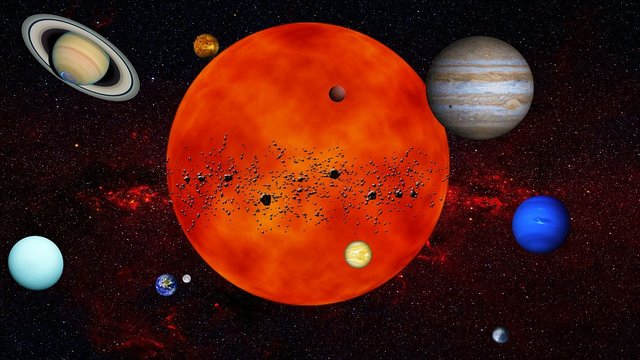
The Solar System
Our Solar System is comprised of a Sun, 8 planets and trillions of asteroids. The planets are split into 2 sub categories which are; 4 terrestrial planets and 4 gas giants.
The Sun
The Sun is the heart of our neighbourhood [1]. It is so massive, that it accounts for 99.8% of the entire mass of the Solar System. Due to such a large mass, its gravity is what keeps everything from the largest of planets to the smallest of particles in orbit around it. Since it is so massive and heavy, it allows for the fusion of Hydrogen which reaches us as light and heat.
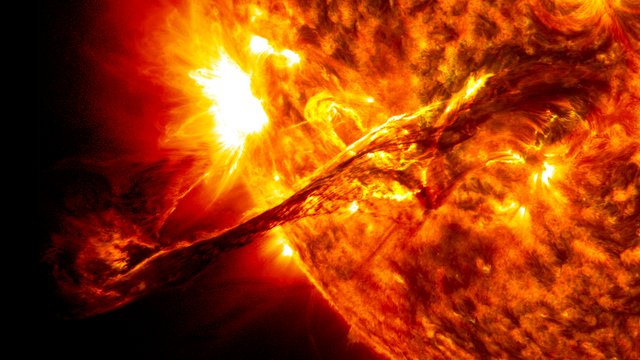
The Terrestrial Planets
As you move away from the Sun, the first 4 planets you encounter are the terrestrial planets. Starting from the closest; we have Mercury.
Mercury
Mercury is the closest planet to the sun. It is also the smallest and lightest. Its year is longer than its day. As a result, the temperature difference between the side facing the sun and the side facing away is huge; temperatures can range between -173 to 427 degrees Celsius [2]. Since it is so small and close to the Sun, it cannot sustain an atmosphere. Mercury has no moon.
Venus
Venus is one of the brightest planets and since it has an atmosphere, it is also by far the hottest, with temperatures ranging from 437 to 497 degrees Celsius [3]. Its atmospheric pressure is almost 100 times higher than that on Earth. Due to it being so close to the Sun, its Greenhouse effect is out of control so as a result, the planet never cools below 437 degrees. That is enough for tin to constantly be molten. Venus has no moon.
Earth
Earth is our home. It just so happens that it is the perfect distance away from the Sun to allow for liquid water. Because of this, humans and plants have been able to thrive. Temperatures range from -89 to 58 degrees Celsius. Earth has 1 moon.
Mars
Mars is slightly more than half the size of Earth [4]. It is slightly too small to sustain an atmosphere (which it once had). Over time its atmosphere was stripped away and its core cooled so much that it solidified. It is home to the largest mountain in the Solar System; which is a little more than 3 times the height of Mount Everest. Mars has 2 moons.
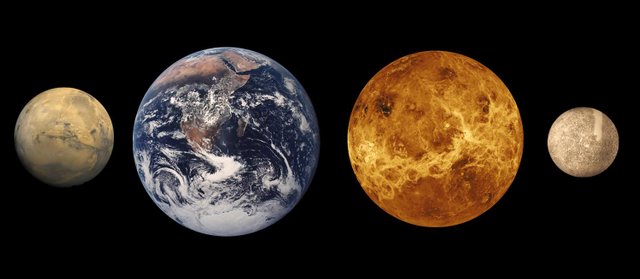
The Gas Giants
After the Terrestrial Planets, we have the Gas Giants. Their name is pretty self-explanatory; they are big balls of gas. After Mars, we have the first Gas Giant; Jupiter.
Jupiter
Jupiter is the largest planet out of them all. It is very like a Star; in that it is largely composed of Hydrogen and Helium. The issue is it never got big enough to start fusing Hydrogen and become one [5]. Temperatures range from -150 to -93 degrees Celsius. You may have heard about the Great Red Spot, which is a huge red spot on the planet; home to a massive storm. It alone, is 3 times the size of Earth! Jupiter has 67 moons.
Saturn
Saturn is the second largest planet after Jupiter and is the least dense out of them all. In fact, if you got a bathtub full of water huge enough for Saturn to sit in it; it would float [6]. Temperatures range from -143 to -133 degrees Celsius. It is most known for its beautiful rings! Saturn has 62 moons.
Uranus
Uranus is the third largest planet after Saturn. Its main feature is that it is so tilted that it orbits the Sun whilst “lay down” on its side. Imagine the North pole on Earth pointing towards the Sun and orbiting in that manner; Uranus does just that. Temperatures range from -200 to -195 degrees Celsius. Uranus has 27 moons.
Neptune
Neptune is so far away that it takes 164 Earth years to orbit the Sun once. Being that far away from the Sun means it must be cold. Temperatures there range from -203 to -197 degrees Celsius. Wind speeds on this Gas Giant have reached 2100 kilometres per hour; that is almost 2 times the speed of sound - that would certainly blow your hat off! Neptune has 14 moons.
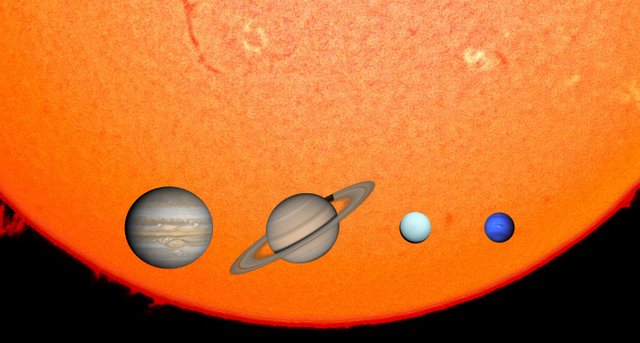
Asteroids
There are literally trillions of asteroids orbiting the Sun in our Solar System. There are 2 main belts; the Asteroid Belt which lies between Mars and Jupiter, and the Kuiper Belt which lies beyond Neptune along the outside of our Solar System [7]. The main object in the Kuiper Belt is the familiar Pluto.
Pluto
Pluto is the smallest planet in the Solar System, and is the largest known object in the Kuiper Belt. It is not very big; in fact, it is half the size of the US in width [8]. Temperatures range from -245 to -218 degrees Celsius. Pluto has 5 known moons.
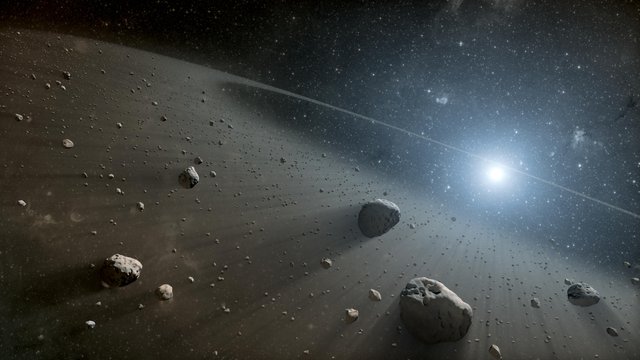
For the purposes of the article being too long, I have kept it nice and concise. I will in future create posts for each specific planet which go into detail about their characteristics (as there is a lot more you need to know about them)!
HINT: Count the planets on your fingers!
I hope you enjoyed this article and best of luck with the challenge! If you want some tips for a top notch response, please read my previous article if you haven’t already seen it.
Please remember to follow all the instructions for a valid response and once you are done, send your response to me on Steemit.chat to make sure I have seen it!
If you have any questions, leave them below and until next time, take care.
~ Mystifact
References:
[1]: https://solarsystem.nasa.gov/planets/sun
[2]: http://coolcosmos.ipac.caltech.edu/ask/17-How-hot-is-Mercury-
[3]: https://www.youtube.com/watch?v=KsF_hdjWJjo
[4]: http://www.lpi.usra.edu/publications/slidesets
[5]: https://spaceplace.nasa.gov/all-about-jupiter/en/
[6]: http://space-facts.com/saturn/
[7]: http://nineplanets.org/uranus.html
[8]: https://theplanets.org/pluto/
Please note; no copyright infringement is intended. All images used have been labelled for re-use on Google Images. If any artist or designer has any issues with any of the content used in this article, please don’t hesitate to contact me to correct the issue.
Relevant articles:
What happens to you in Space without a Spacesuit?
Are we alone in the Universe?
Can we turn Mars into Earth 2.0?
Previous articles:
MystiFACT-or-FICTION challenge #1 - RESULTS
Solids, Liquids and Gases… Is that it? – Part 2
Solids, Liquids and Gases… Is that it? – Part 1
Follow me on: Facebook, Twitter and Instagram, and be sure to subscribe to my website!
Now that the mistake has been publicly announced in the comments, I expect extra creativity with your responses. Go nuts! Best of luck.
Downvoting a post can decrease pending rewards and make it less visible. Common reasons:
Submit
Downvoting a post can decrease pending rewards and make it less visible. Common reasons:
Submit
Great! You have found the mistake, now for the next part of the challenge :) Look forward to reading your response.
Downvoting a post can decrease pending rewards and make it less visible. Common reasons:
Submit
Great post! However, in this article under Mercury you said, "Its year is longer than its day." Are you referring to Mercury's "sidereal day" or "solar day"? I assumed solar, and posted my response with what I felt were actually 2 mistakes in this post.
Downvoting a post can decrease pending rewards and make it less visible. Common reasons:
Submit
It seems like we have an expert on the topic. I would have never spotted something like this ^_^
Downvoting a post can decrease pending rewards and make it less visible. Common reasons:
Submit
Lol, I'm no expert! I actually erroneously read the sentence as, "Its day is longer than its year" the first time through. I looked it into it further (to prove it wrong) and discovered that depending on the definition of "day" one chooses it could actually be true! The hint at the bottom made it obvious the error was with classifying Pluto as a planet, but I was curious and figured I would bring it up anyways.
Downvoting a post can decrease pending rewards and make it less visible. Common reasons:
Submit
Hi! Sadly, that isn't the mistake. In Astronomy, if you refer to a day or year, it is most of the time Solar and not Sidereal. Thank you for your response nevertheless, and it is still valid for your hard work, unless you would like to submit another one. Best of luck!
Downvoting a post can decrease pending rewards and make it less visible. Common reasons:
Submit
I found this site which says: "Based on data obtained by these radar measurements, Mercury is now known to be in 3:2 orbital resonance with the Sun. This means that the planet completes three rotations on its axis for every two orbits it makes around the Sun. At it’s current rotational velocity – 3.026 m/s, or 10.892 km/h (6.77 mph) – it takes Mercury 58.646 days to complete a single rotation on its axis. While this might lead some to conclude that a single day on Mercury is about 58 Earth days – thus making the length of a day and year correspond to the same 3:2 ratio – this would be inaccurate. Due to its rapid orbital velocity and slow sidereal rotation, a Solar Day on Mercury (the time it takes for the Sun to return to the same place in the sky) is actually 176 days."
https://www.universetoday.com/47834/length-of-day-on-mercury/
Downvoting a post can decrease pending rewards and make it less visible. Common reasons:
Submit
Interesting... I think with Astronomy especially, everything we know has a certain level of uncertainty. It is widely known that a day on Mercury is 88 Earth days so in my opinion, that is the "most accepted" theory out there.
Downvoting a post can decrease pending rewards and make it less visible. Common reasons:
Submit
Hey no problem, we can agree to disagree. Good luck with your future posts/challenges!
Downvoting a post can decrease pending rewards and make it less visible. Common reasons:
Submit
super
Downvoting a post can decrease pending rewards and make it less visible. Common reasons:
Submit
Thank you!
Downvoting a post can decrease pending rewards and make it less visible. Common reasons:
Submit
Very much informative article. Learnt many things about the members of our solar system.
But one thing I want to point out. The scientist community has recently demoted Pluto from being a planet. Now, it's not the part of the Nine planets (now eight).
Now, Pluto is considered as a Dwarf Planet and with it's inclusion the number of dwarf planets becomes five.
Downvoting a post can decrease pending rewards and make it less visible. Common reasons:
Submit
Well done :) You have found the mistake! I now look forward to your challenge response
Downvoting a post can decrease pending rewards and make it less visible. Common reasons:
Submit
@nitesh9 is right. Pluto is not the 9th planet for about 10 years. But there is actually a 'Planet 9' that is widely searched for today (there are signs for it) :)
Downvoting a post can decrease pending rewards and make it less visible. Common reasons:
Submit
Correct, now for the next part of the challenge. I look forward to your response!
Downvoting a post can decrease pending rewards and make it less visible. Common reasons:
Submit
I pass :p
Downvoting a post can decrease pending rewards and make it less visible. Common reasons:
Submit
lol
Downvoting a post can decrease pending rewards and make it less visible. Common reasons:
Submit
Nice Post! Hopefully I'll have enough time this week to write a response.
Downvoting a post can decrease pending rewards and make it less visible. Common reasons:
Submit
Thank you for your comment :) I look forward to reading it!
Downvoting a post can decrease pending rewards and make it less visible. Common reasons:
Submit
Great post, I am looking forward to participating in this challenge again, and have uploaded my response. Hopefully I can do as well as last time!
Downvoting a post can decrease pending rewards and make it less visible. Common reasons:
Submit